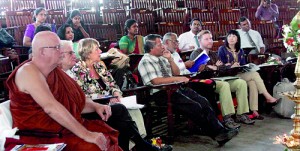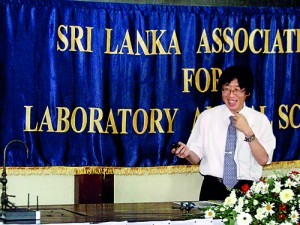News
Call to reduce using animals as lab objects
It was the ‘day of the humble guinea pig’, when like-minded scientists, veterinarians and researchers discussed ways and means of producing models to cut down on animal experiments.

The gathering including Ven. Olande Ananda Thera and Prof. Vera Baumans at the Inaugural Scientific Conference of SLALAS. Pix by Indika Handuwala
Held in the historic amphitheatre of the Colombo Medical Faculty’s Department of Physiology recently, it was also a historic event.
The event was none other than the Inaugural Scientific Conference of the Sri Lanka Association for Laboratory Animal Science (SLALAS) headed by Prof. Mangala Gunatilake, where both local and foreign participants from across the world discussed crucial issues linked to the sensitive subject of animal experimentation.
With the theme being ‘Advancement in prevention and treatment of diseases through research on animal and alternative models’ the conference was preceded by a workshop at the Uva Wellassa University followed by another at the Colombo Medical Faculty. These workshops were also a first in the country.
While the international speakers were from the Netherlands, Japan, Belgium, Thailand, India and Malaysia, a highlight of the conference was a talk by Ven. Olande Ananda Thera of the Pagoda Meditation Centre, Nugegoda. The conference was supported by the Association for Assessment and Accreditation of Laboratory Animal Care International and its Senior Director for Southeast Asia, Dr. Montip Gettayacamin also participated in the sessions.

Prof. Mangala Gunatilake at the inauguration of SLALAS back in 2012. Pic by M.A. Pshpa Kumara
Pointing out that animal experiments have inextricably been linked to human wellbeing, Prof. Gunatilake who is attached to the Colombo Medical Faculty’s Department of Physiology, reiterated that through the testing of medications using animals, human recovery from illness has progressed a long way.
There have also been major scientific discoveries through animal experiments but there is a need to have strong guidelines and ethical reviews, she said.
“Alternatives are considered to be more humane, cost-effective, rapid and reliable than traditional animal tests,” she said, urging however that it is necessary to validate or evaluate these methods scientifically in multiple laboratories to see whether their results predict outcomes in humans reliably.
This is why an exhaustive workshop was held in 2008 by the Colombo Medical Faculty’s Ethics Review Committee in the wake of which came the development of National Guidelines for the Protection of ‘Animal Participants’ in Research. In 2009, the Guidelines for Ethics Review of Research Proposals Involving Animals, the first comprehensive document in this field followed. The work in the field did not end there but included several workshops and the launch of the First International Certificate Course on Laboratory Animal Science in the Asian region at the Colombo Medical Faculty in November/December 2011.
The highlight, however, was the establishment of SLALAS in 2012.
Referring to alternatives to animal testing, Prof. Gunatilake said they would minimise or prevent the use of live animal models for

Prof. Noriyuki Koibuchi addressing the gathering
testing and research. They include embryonated chicken eggs, zebra-fish egg model, computer models, computer-operated mannequins which are called crash-test dummies, in-silico computer simulations, in-vitro cell cultures which include EpiDerm, EpiSkin and SkinEthic RHe models and in-vitro organs.
Alternatives are test methods which have been developed by scientists to incorporate and implement ‘replacement’ under the 3R concept of ‘Replacement, Reduction and Refinement’ introduced way back in 1959 by William Russell and Rex Burch under ‘Principles of humane experimental techniques’.
The 3R concept is to be used as a tool to diminish or remove the suffering of animals used for experimental purposes, it is learnt.
Pointing out that in the face of scientific advancement, where with genetic manipulation, cloning and stem-cell research applications, the sky seems to be the limit, the world is coming across new ethical problems, said Ven. Olande Ananda Thera. He quoted Albert Einstein who has said that it is humankind’s duty to respect all life and that not only animals but even trees and plants have feelings.
“Animals are seen as beings that would have been a human in a previous life, but due to bad karmic actions, found a lower form of existence. Therefore, all beings are inter-related and each and everyone, including animals, could have been your father, mother, sister or brother,” he said, adding that in the time of the Buddha there were no experiments on animals for the advancement of medicines for human beings.
“Mostly the system of ayurveda was used to treat illnesses,” he said, hastening to add however that he is not proposing the stopping of research and development in the medical field but focusing on certain points of reflection.
Presenting a lucky charm in the form of a mouse, at the sessions, Chief Guest Prof. Vera Baumans, from the Utrecht University in the Netherlands, picked on the ‘refinement’ aspect of the 3Rs, to reduce the incidence and severity of painful, distressing or discomforting routine procedures in laboratory animals.
Housing systems for captive animals have often been designed on the basis of economic and ergonomic aspects with little or no consideration for animal welfare, said this Professor from the Department of Animals, Science and Society of the Div. Laboratory Animal Science, stressing that a little manipulation through environmental refinement could improve the animals’ living conditions.
“It is important to evaluate environmental refinement in terms of the benefit to the animal, by assessing the use of and preference for certain refinements, the effect on behaviour and the performance of species-typical behaviour on physiological parameters,” she said.
There is evidence that routine procedures that laboratory animals are subjected to such as handling and restraint, cage-cleaning, injections and blood sampling which are thought to cause only minor discomfort, in fact cause acute stress responses, according to her.
When housing animals including mice, rats, rabbits, primates, cats and dogs, simple things that should be considered are whether rats and mice should be housed together; should rabbits be provided a box to sit on and communicate with their cage-mates; would the noise of a tap dripping or the rattling of metal as the cage door is opened have an impact on small rodents; what if music such as Beethoven or Mozart is played in the background to mask this sound; and whether there is animal aggression after cage-cleaning.
What is needed is to take species-specific behaviour into account, says Prof. Baumans, asking whether animals should be provided a mirror, not to see their image but to see who is entering the animal house through the door.
It is important to add ‘responsibility’ to the 3Rs, she added.
Meanwhile, the guest lecture on ‘How useful animal models are to study the role of thyroid hormones on cerebellar development’ was delivered by Prof. Noriyuki Koibuchi of Japan’s Gunma University Graduate School of Medicine and the ‘Contribution of the Medical Research Institute in the development of the laboratory animal science field in Sri Lanka’ by MRI’s Head/Animal Centre, Dr. Mayuri Thammitiyagodage.


